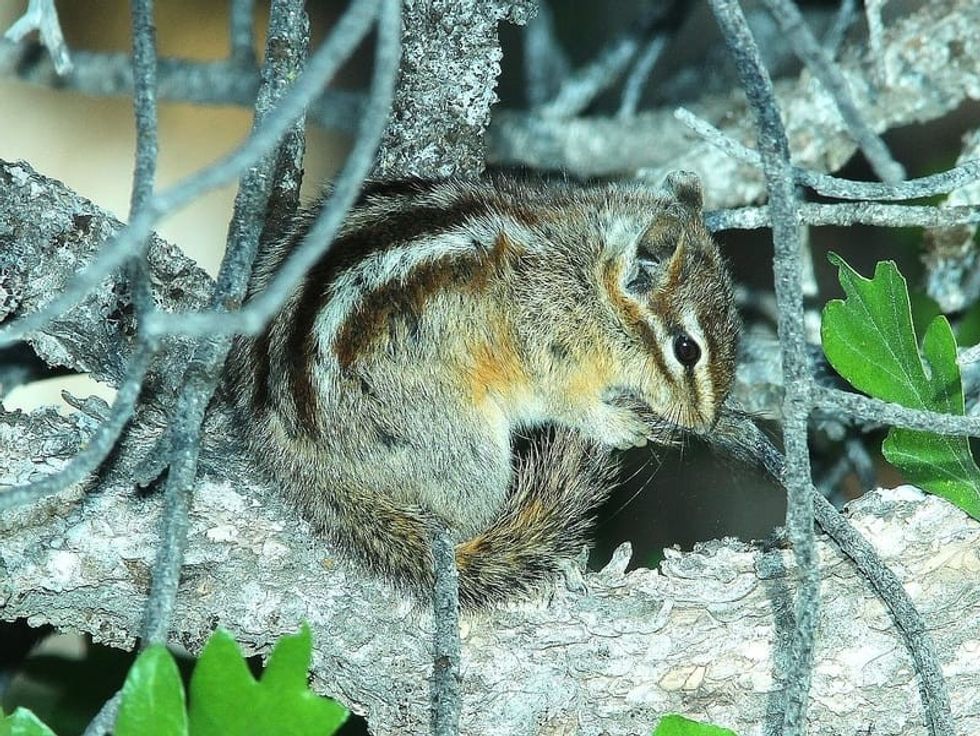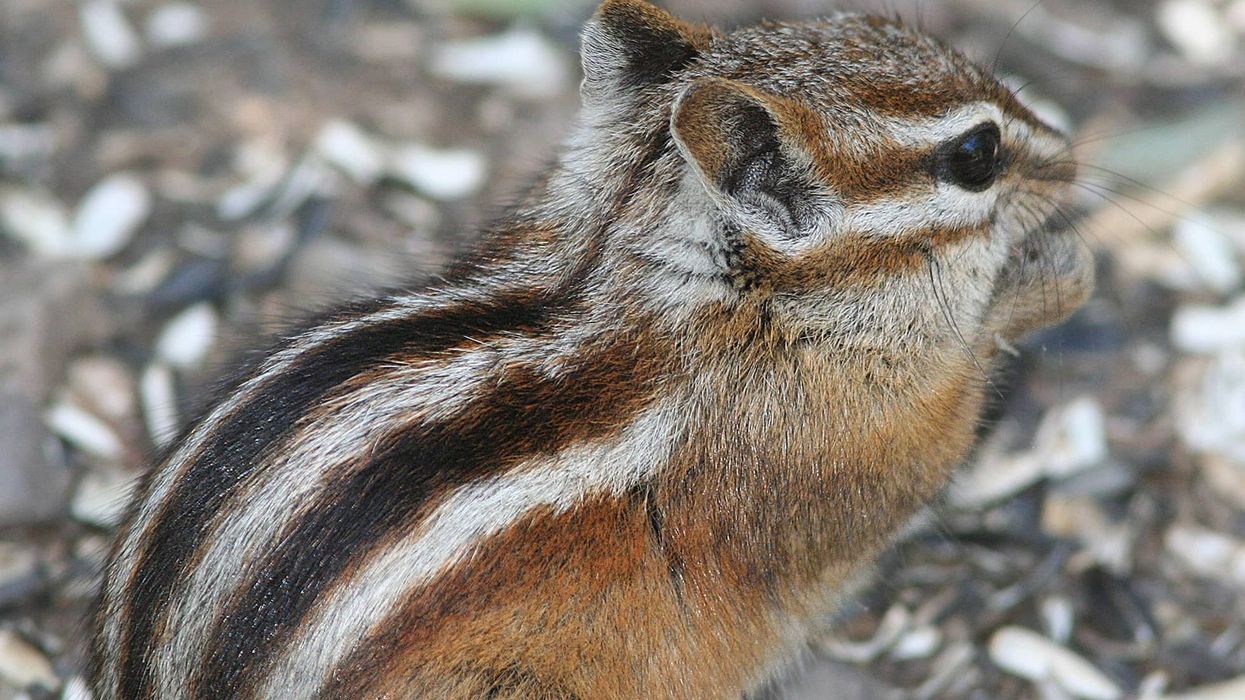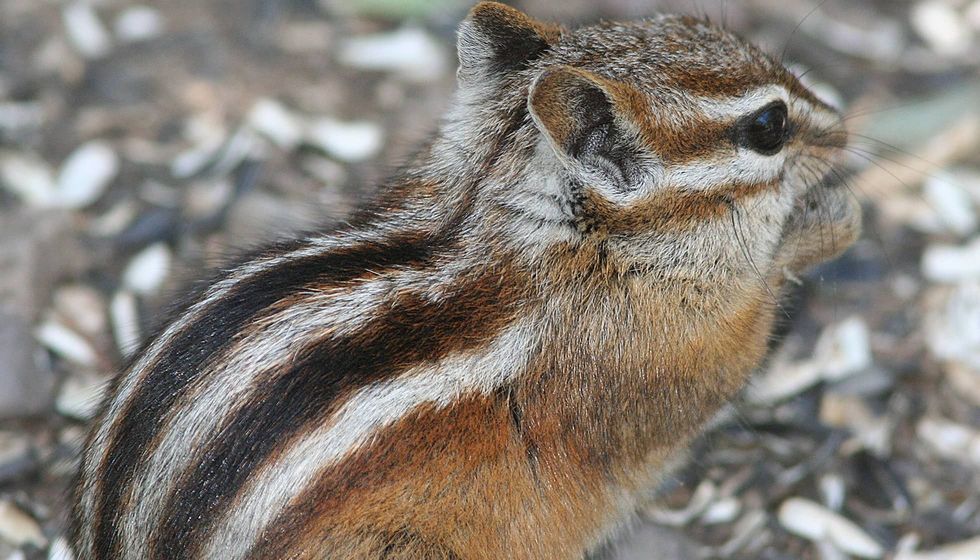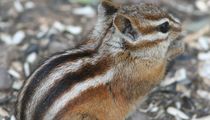Fun Least Chipmunk Facts For Kids

Have you heard about the Least Chipmunks? The Neotamias minimus is the smallest chipmunk species and is distributed throughout North America.
They are cute little creatures generally seen running around through the undergrowth of a wide variety of areas, such as the forest of alpine trees and shrubs and bushes. They inhabit forest edges, rock cliffs, and river bluffs. Their winter nests are underground burrows.
While during the summer season, they build nests in trees with leaves and bark or tree cavities above the ground or rotting logs. The food of the Least chipmunk (Tamias minimus) consists of fruits, grasses, fungi, snails, nuts, and seeds. The Least chipmunks carry the seeds on their cheek.
The females can yield another litter if the previous litter is lost. They frequently wake up to feed on their stored food during the winter months.
Enjoy reading the interesting facts about the most widespread North American Least chipmunk; recall the famous animated series 'Chip n Dale' days! Also, find out about chipmunks and squirrels.
Least Chipmunk Interesting Facts
What type of animal is the Least Chipmunk?
The Least chipmunk is a smart, intelligent, and affectionate little animal. The Neotamias minimus uses the cheek pouches to transport and store food.
What class of animal does a Least Chipmunk belong to?
The Least chipmunks belong to the kingdom Animalia, phylum Chordata, class Mammals, order Rodentia, genus Neotamias, and family Sciuridae.
How many Least Chipmunks are there in the world?
The exact number is unknown since the Least chipmunk (Tamias minimus) is widely distributed. Twenty-five genus species are found. They are found throughout North America.
Where does the Least Chipmunk live?
The Least chipmunk mammals prefer boreal and temperate forests. Their habitat comprises coniferous woodlands, sagebrush, alpine meadows, and forests of the northern tundra region. The Least chipmunk wanders around their preferable areas, such as forest edges.
The Least chipmunk range throughout North America, starting from the northern side of New Mexico and western north and south Dakota to the eastern side of California, Washington, and Oregon. It is distributed in the forest range of southern and western Canada.
It occupies Yukon's south-eastern part of British Columbia, to Ontario, Michigan, Minnesota, and Wisconsin. In Michigan, the Neotamias minimus is found in the upper peninsula.
What is the Least Chipmunk's habitat?
The home ranges of the Neotamias minimus vary. They are commonly found in rural, suburban, and urban areas, parks, gardens, and campgrounds. They are active during the day.
The chipmunks prefer open areas such as forest edges, boreal and temperate forests, rock cliffs, river bluffs, and underground burrows. They usually build burrows under stone walls bordering woods or under the bush, rocks, and tree roots. The only area you will not find them is a marshy area with dense undergrowth.
It is pretty common to find them running around mature trees. The home ranges of the females are more unique than the males. Nests of the Neotamias minimus depend on the season. They built their nests high off the ground. The Least chipmunks are most active between April and October.
During the summer months, the nests are made of rotting logs, leaves, bark, or tree cavities. In winter, nests are built in underground burrows out of bark, dried grass, feathers, fur, and soft plant material.
The burrow comprises a single chamber 5.9 (15 cm) diagonally and 5.7 in (1.7 m) in length. The Neotamias minimus spends their winter months in the burrows and partially hibernate. They wake up periodically to feed on their stored foodstuffs.
Who do Least Chipmunks live with?
The Neotamias minimus lives together in the form of a colony. Around 8 to 10 chipmunks live in a small colony. The Least chipmunks usually become aggressive when protecting their territories and foodstuffs.
They mark scents using their urine and cheeks. The Least chipmunks are social during the mating season or raising their offspring. They depend on body posture, tail movement, and auditory signals for communicating with their kind.
How long does the Least Chipmunk live?
The Least chipmunk species can live up to six years when kept in captivity.
How do they reproduce?
For breeding, the Least chipmunks built their nests high. After a week of getting out from the burrows in the spring season, the females enter the estrus cycle. Coupling takes place between March and May. The gestation period lasts from 28-30 days. A less efficient placenta can restrict the gestation period.
A single litter size comprises three to seven young ones or offspring born every year. There is usually a single litter during the breeding season, though females whose litter is lost can breed once again to reproduce young ones or offspring within the same year.
The young ones or offspring are born hairless and blind. They measure around 2 in (5 cm) in length and weigh around 0.2 oz (6 g).
The young ones or offspring open their eyes when they are 28 days old, and the average weaning age is 60 days. The young ones feed on milk till they are 60 days old and become mature when they are one year old.
What is their conservation status?
The conservation status of the Least Chipmunk is ‘Least Concern’.
Least Chipmunk Fun Facts
What do Least Chipmunks look like?
The Least chipmunk is the smallest chipmunk species. Many people get confused with the golden-mantled ground squirrel.
But the Least chipmunk mammals are different from the ground squirrel. The body color of Least chipmunk mammals varies from gray to reddish-brown, and the underparts are grayish-white. The backside of the body comprises five dark brown to black lines and is divided with white stripes.
The lines start from the neck and end at the base of the tail. Also, two light and dark stripes are on the face.
The lines run from the tip of the nose to the ears. Its beautiful bushy tail is orange-brown. The chipmunks love to use their tail and run around with their tail straight upwards.
Like other chipmunk species, the Neotamias minimus has four toes on each forefoot and five on the hind feet. The females also have mammary glands to feed their young ones.

How cute are they?
Least Chipmunks are very cute with their tiny size and puffy cheeks where they store their food. The stripe down their body makes them look attractive too.
How do they communicate?
The Neotamias minimus communicates through different vocal sounds. The Least chipmunk vocalization comprises from fast chirping sound to a squawk. Also, it is interesting to hear the Least chipmunk call when danger approaches.
When the Least chipmunks see a predator, they make a call. A shrill or repeated chirping sound may shoo away many predators like a domestic cat. Cats often give up their hunt as the chipmunks' shrilling sounds serve as a defense and warn each other.
The visual forms of communication of the Least chipmunks include auditory signals, body posture, and tail movement. Other forms of communication include marking their territory with cheek scent glands and urine.
How big is the Least Chipmunk?
The Least chipmunk size is 6.2-9.8 in (15.7-25 cm). It is two times smaller than the Eastern chipmunk.
How fast can the Least Chipmunk run?
The Neotamias minimus mammals can travel at a speed of 21 mph.
How much does the Least Chipmunk weigh?
The weight of the Least chipmunk mammals is 0.9-2.3 oz (25-66 g).
What are the male and female names of the species?
The male Least chipmunk is known as a buck, and the females are known as does.
What would you call a baby Least Chipmunk?
The baby Least chipmunks are known as pups, kits, or kittens.
What do they eat?
The Least chipmunk (Tamias minimus) feeds on fruits, grasses, fungi, snails, insects, berries, flowers, mushrooms, nuts, and seeds. The Least chipmunk babies feed on their mothers' milk till they are 60 days old. Their habitat choice and range depend on food availability in the area.
Due to their food storage habit, they carry seeds and nuts from various trees and plants. Thus, this species acts as the main disperser of these seeds. Conversely, the Neotamias minimus is eaten by many predators like hawks, owls, and mustelids.
Are they dangerous?
No, the Least Chipmunks are not dangerous to humans. But, although they are harmless, they are known to carry a wide variety of diseases like rodents and can spread to you and your family members.
The Least chipmunks can bite a little with their tiny teeth or scratch if only they feel threatened. In the wild, the Least chipmunks don't carry rabies.
Would they make a good pet?
Yes, the Least chipmunks would make a good pet. Most people consider them garden pets. Although they are intelligent and affectionate, keeping them in captivity would be difficult since they mark scent using their urine. Also, they hibernate partially during the falls.
The chipmunks do not carry rabies in the wild; however, some in North America are known to carry the plague. Although the chipmunks are cute and friendly, avoid them when sick.
Did you know...
The common diseases of chipmunks include - salmonella, rabies, encephalitis, plague, hantavirus, leptospirosis, and the Rocky Mountain spotted fever. Some diseases are also caused due to direct contact with their feces, urine, pests, and indirectly through fleas and ticks.
During the fall, the Least chipmunk habitat varies according to latitude. For example, they stay in Michigan from November to March, whereas they stay in northern Manitoba between April and October.
Many birds and animals eat chipmunks. The main predators include cats, dogs, weasels, snakes, owls, hawks, foxes, raccoons, bobcats, coyotes, lynxes, and even their relatives, the red squirrels, depending on the location.
Least chipmunk vs eastern chipmunk- the eastern chipmunk is the largest while the Least chipmunk is the smallest.
What does the Least Chipmunk do to survive in its environment?
Compared to other chipmunks, the Least chipmunk (Tamias minimus) species has excellent tolerance for heat, a lower dehydration rate, the medullar thickness of the kidney is high and concentrated urine is also high. Due to these adaptations, the Least chipmunks' habitat choice varies. Their habitat comprises sagebrush, coniferous woodland, and alpine meadows, which is impossible for other chipmunk species.
The Neotamias minimus' main form of defense consists of running away from predators. They warn other chipmunks about the impending danger. They run away or stay in their burrows and give alarm signals.
The chipmunks respond to the warning alarms by staying inside their burrows where predators can't reach them. The chipmunks searching for food will use the shortest route to home after hearing an alert. Mostly, they choose habitats with dense undergrowth, rock piles, logs, and tree cavities to hide from their predators.
The Least chipmunk remains alert when searching for food. The most outstanding defense is speed, especially when they are alone and no one is there to alert them.
They are so fast that they can quickly get away from their predators. With one jump, they are out of reach. The Least chipmunk is so tiny that it can easily navigate the dense shrubs and bushes.
Do chipmunks play dead?
The Least chipmunks can play dead. They are smart and intelligent little animals. They not only play dead but are also fast runners and can climb curtains and jump from windows.
The Least chipmunks are known to play dead to trick their predators. This process of playing dead is known as thanatosis. It is a way to trick the predators and watch for movement in some of its potential prey.
Here at Kidadl, we have carefully created lots of interesting family-friendly animal facts for everyone to discover! Learn more about some other mammals including the field vole or American mink.
You can even occupy yourself at home by drawing one of the Least Chipmunk coloring pages.
We Want Your Photos!
More for You
See All
Master of Computer Science

Abhijeet ModiMaster of Computer Science
An experienced and innovative entrepreneur and creative writer, Abhijeet holds a Bachelor's and Master's degree in Computer Application from Birla Institute of Technology, Jaipur. He co-founded an e-commerce website while developing his skills in content writing, making him an expert in creating blog posts, website content, product descriptions, landing pages, and editing articles. Passionate about pushing his limits, Abhijeet brings both technical expertise and creative flair to his work.
Bachelor of Arts specializing in English Language and Literature, Master of Arts specializing in Philosophy and Religious Studies

Tehil DavidBachelor of Arts specializing in English Language and Literature, Master of Arts specializing in Philosophy and Religious Studies
Tehil David Singh is a fact checker with a Bachelor's degree in English literature from St.Xavier's College, Palayamkottai, and a Master's degree in Philosophy, and Religion from Madurai Kamaraj University. He has a passion for writing and hopes to become a story writer in the future. Tehil has previously interned in content writing and has been a content creator for the last three years. In his personal life, he enjoys singing, songwriting, performing, and writing stories.
Disclaimer
1) Kidadl is independent and to make our service free to you the reader we are supported by advertising. We hope you love our recommendations for products and services! What we suggest is selected independently by the Kidadl team. If you purchase using the Buy Now button we may earn a small commission. This does not influence our choices. Prices are correct and items are available at the time the article was published but we cannot guarantee that on the time of reading. Please note that Kidadl is a participant in the Amazon Services LLC Associates Program, an affiliate advertising program designed to provide a means for sites to earn advertising fees by advertising and linking to Amazon. We also link to other websites, but are not responsible for their content.
2) At Kidadl, we strive to recommend the very best activities and events. We will always aim to give you accurate information at the date of publication - however, information does change, so it’s important you do your own research, double-check and make the decision that is right for your family. We recognise that not all activities and ideas are appropriate for all children and families or in all circumstances. Our recommended activities are based on age but these are a guide. We recommend that these ideas are used as inspiration, that ideas are undertaken with appropriate adult supervision, and that each adult uses their own discretion and knowledge of their children to consider the safety and suitability. Kidadl cannot accept liability for the execution of these ideas, and parental supervision is advised at all times, as safety is paramount. Anyone using the information provided by Kidadl does so at their own risk and we can not accept liability if things go wrong.
3) Because we are an educational resource, we have quotes and facts about a range of historical and modern figures. We do not endorse the actions of or rhetoric of all the people included in these collections, but we think they are important for growing minds to learn about under the guidance of parents or guardians.







